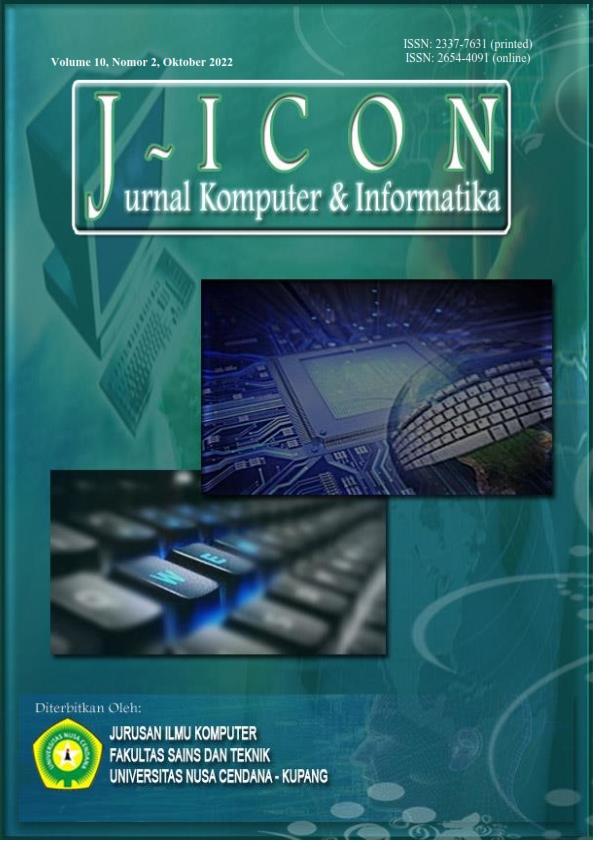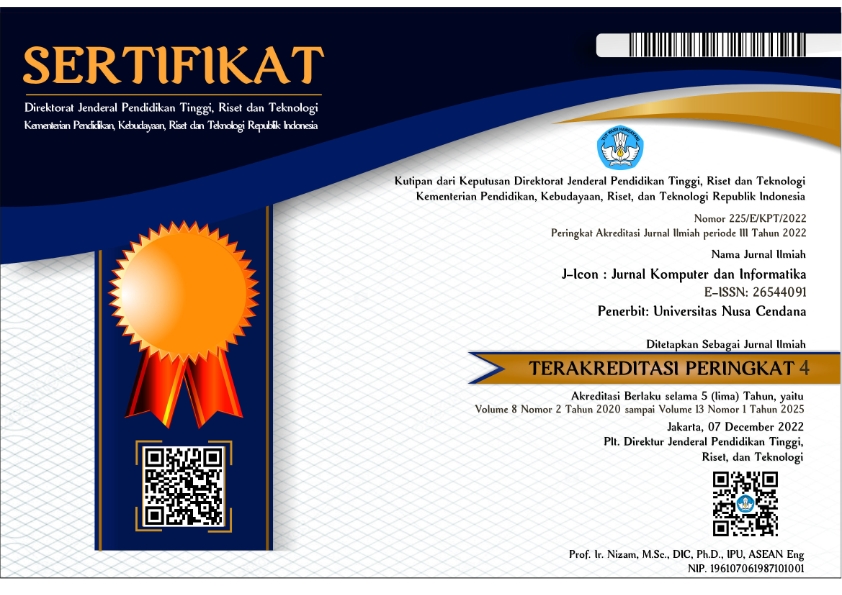ALUMNI JOB WAITING PERIOD PREDICTION USING NAÏVE BAYES CLASSIFIER AT COMPUTER SCIENCE STUDY PROGRAM UNIVERSITY OF NUSA CENDANA
Abstract
In a global era that is full of challenges, universities are expected to produce quality graduates in order to compete in the world of work. One indicator that can be used to assess the quality of graduates is the job waiting period. In this research, the researcher implements Naïve Bayes Classifier method using the RapidMiner 7.3 app to generate predictions for the job waiting period and the accuracy rate of the prediction results obtained. The data in this research were obtained from the results of the Tracer Study questionnaire distributed by Computer Science Study Program at The University of Nusa Cendana to determine the career achievements of alumni. The attributes used in this research are Study Period, Grade Point Average (GPA), Organizational Participation, and Competency Mastery with Waiting Period classes which are divided into 4, namely ≤ 10 months, 11 months - 2 years 1 month, 2 years 2 months - 3 years 4 months, and > 3 years 4 months. The prediction results of the job waiting period obtained are presented in the form of a confusion matrix with an accuracy rate of 81.82%.
Downloads
References
M. Kadarisman, “Tantangan Perguruan Tinggi dalam Era Persaingan Global,” Sociae Polites, pp. 3–20, Oct. 2017, doi: 10.33541/sp.v1i1.459.
S. A. Pattekari and A. Parveen, “Prediction System for Heart Disease Using Naïve Bayes,” International Journal of Advanced Computer and Mathematical Sciences, vol. 3, no. 3, pp. 290–294, 2012.
F. E. Prabowo and A. Kodar, “Analisis Prediksi Masa Studi Mahasiswa Menggunakan Algoritma Naïve Bayes,” Jurnal Ilmu Teknik dan Komputer, vol. 3, no. 2, pp. 147–151, Jul. 2019, doi: 10.22441/jitkom.2020.v3.i2.008.
A. H. Mirza, “Penerapan Algoritma Naive Bayes Classifier dalam Menentukan Strategi Promosi Penerimaan Mahasiswa Baru,” Journal of Information Systems and Informatics, vol. 1, no. 1, pp. 14–28, Mar. 2019.
D. Novianti, “Implementasi Algoritma Naïve Bayes Pada Data Set Hepatitis Menggunakan Rapid Miner,” Jurnal Sistem Informasi, Teknik Informatika, Software Engineering, dan Multimedia, vol. 21, no. 1, pp. 49–54, Mar. 2019, doi: 10.31294/p.v21i1.4979.
H. Annur, “Klasifikasi Masyarakat Miskin Menggunakan Metode Naive Bayes,” ILKOM Jurnal Ilmiah., vol. 10, no. 2, pp. 160–165, Aug. 2018, doi: 10.33096/ilkom.v10i2.303.160-165.
A. S. Fitriani, “Penerapan Data Mining Menggunakan Metode Klasifikasi Naïve Bayes untuk Memprediksi Partisipasi Pemilihan Gubernur,” JTAM (Jurnal Teori dan Aplikasi Matematika), vol. 3, no. 2, pp. 98–104, Oct. 2019.
I. K. Syahputra, F. A. Bachtiar, and S. A. Wicaksono, “Implementasi Data Mining untuk Prediksi Mahasiswa Pengambil Mata Kuliah dengan Algoritme Naive Bayes,” Jurnal Pengembangan Teknologi Informasi dan Ilmu Komputer, vol. 2, no. 11, pp. 5902–5910, Nov. 2018.
R. Cahyaningtyas, Luqman, and R. Y. I. Heriyanto, “Klasifikasi Kompetensi Alumni Berdasarkan Masa Tunggu Alumni untuk Mendapatkan Pekerjaan Menggunakan Metode Algoritma C4.5,” Jurnal KILAT, vol. 9, no. 2, pp. 297–310, Oct. 2020.
Khoirudin, S. Hadi, and A. Nugroho, “Analisa dan Penerapan Metode Neural Networks dalam Mengidentifikasi Faktor-Faktor Masa Tunggu Kerja Lulusan,” Jurnal Pengembangan Rekayasa dan Teknologi, vol. 16, no. 1, pp. 17–22, Jun. 2020, doi: 10.26623/jprt.v16i1.2399.
M. J. Zaki and W. Meira, Data Mining and Analysis: Fundamental Concepts and Algorithms. New York, NY: Cambridge University Press, 2014.
Bustami, “Penerapan Algoritma Naive Bayes untuk Mengklasifikasi Data Nasabah Asuransi,” JURNAL INFORMATIKA, vol. 8, no. 1, pp. 884–898, Jan. 2014.
T. R. Patil and M. S. S. Sherekar, “Performance Analysis of Naive Bayes and J48 Classification Algorithm for Data Classification,” International Journal of Computer Science and Applications, vol. 6, no. 2, pp. 256–261, Apr. 2013.
A. H. Wiltshire, “The Meanings of Work in A Public Work Scheme in South Africa,” International Journal of Sociology and Social Policy, vol. 36, no. 1/2, pp. 2–17, Mar. 2016, doi: 10.1108/IJSSP-02-2015-0014.
I. Mierswa, M. Wurst, R. Klinkenberg, M. Scholz, and T. Euler, “YALE: Rapid Prototyping for Complex Data Mining Tasks,” in Proceedings of the 12th ACM SIGKDD international conference on Knowledge discovery and data mining, USA, 2006, pp. 935–940. doi: 10.1145/1150402.1150531.
M. Hofmann and R. Klinkenberg, RapidMiner: Data Mining Use Cases and Business Analytics Applications. USA: CRC Press, 2016. [Online]. Available: https://books.google.co.id/books?id=Y_wYCwAAQBAJ
U. M. Fayyad, G. Piatetsky-Shapiro, and P. Smyth, “Knowledge Discovery and Data Mining: Towards a Unifying Framework.,” in KDD, 1996, vol. 96, pp. 82–88.
J. Han, J. Pei, and M. Kamber, Data Mining: Concepts and Techniques, 3rd ed. USA: Morgan Kaufmann Publishers, 2011. [Online]. Available: https://books.google.co.id/books?id=pQws07tdpjoC
Copyright (c) 2022 Rachmadiansyah Rachmadiansyah, Nelci Dessy Rumlaklak, Arfan Yeheskiel Mauko

This work is licensed under a Creative Commons Attribution 4.0 International License.
The author submitting the manuscript must understand and agree that if accepted for publication, authors retain copyright and grant the journal right of first publication with the work simultaneously licensed under a Creative Commons Attribution (CC-BY) 4.0 License that allows others to share the work with an acknowledgment of the work’s authorship and initial publication in this journal.
 Rachmadiansyah Rachmadiansyah(1*)
Rachmadiansyah Rachmadiansyah(1*)




